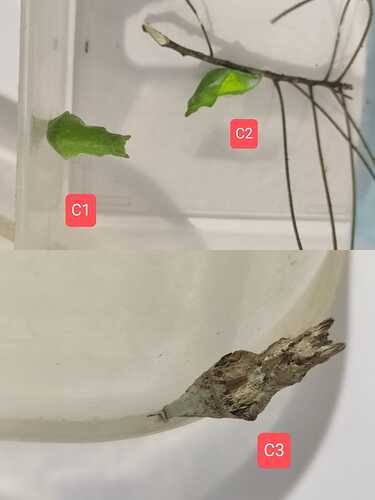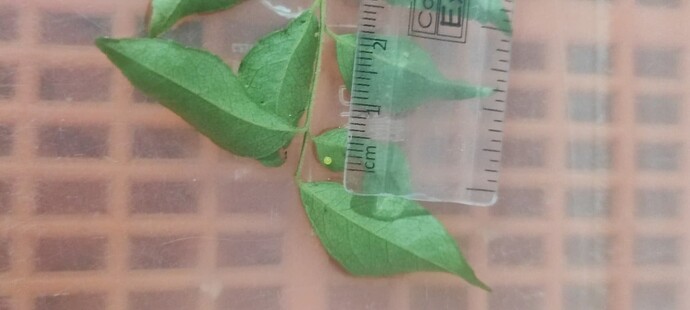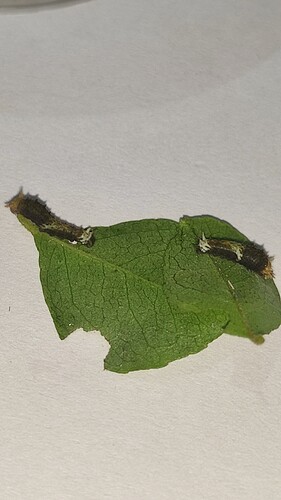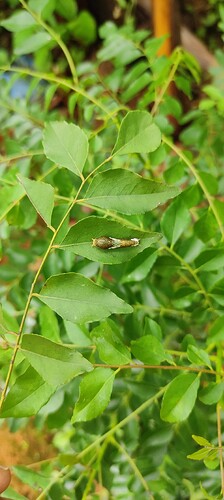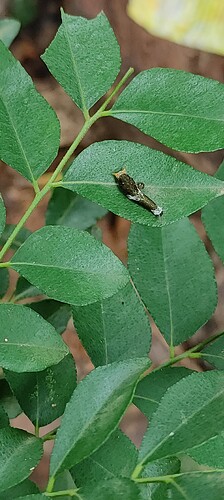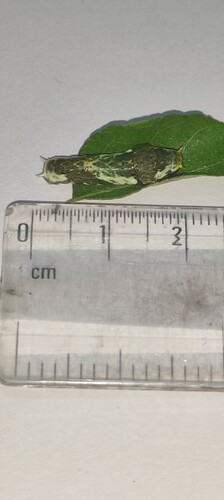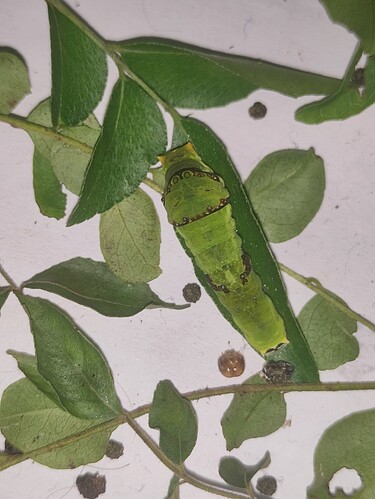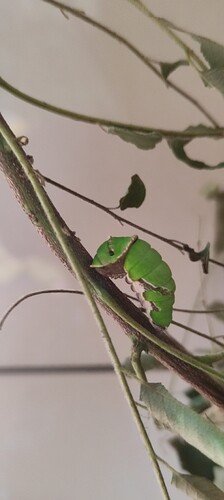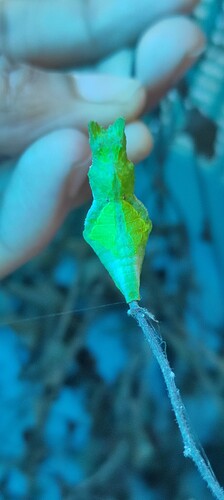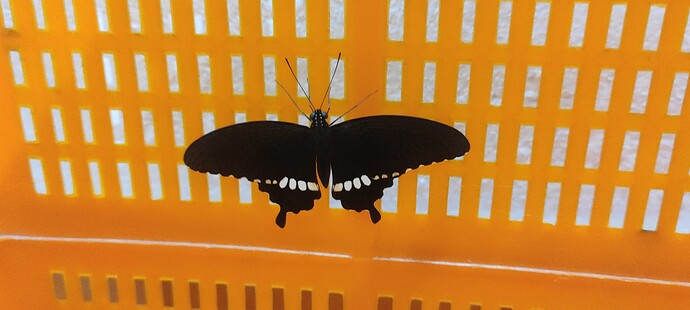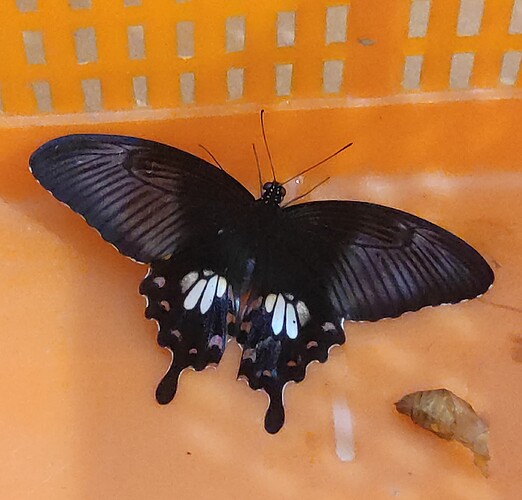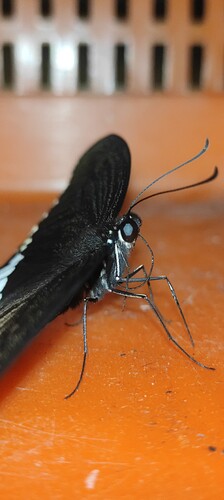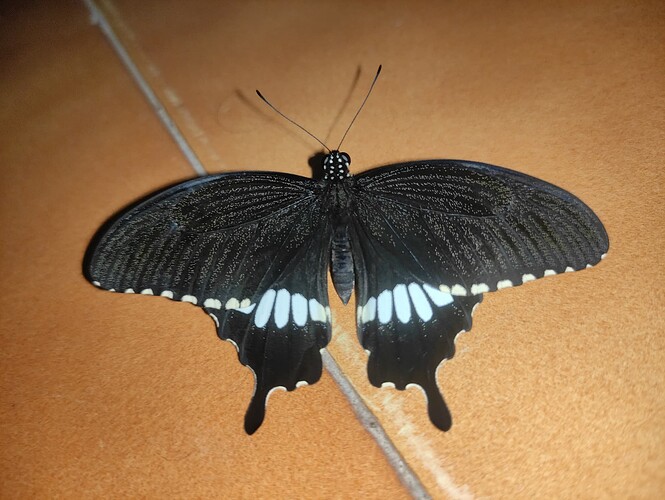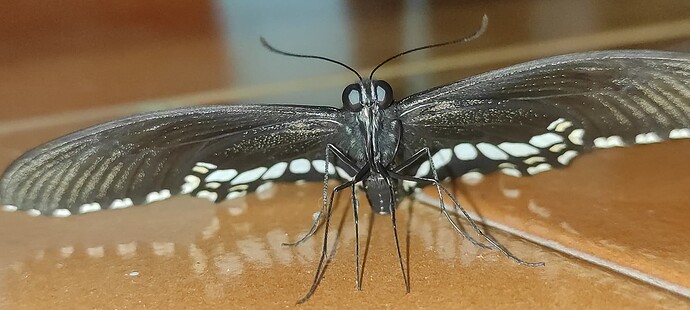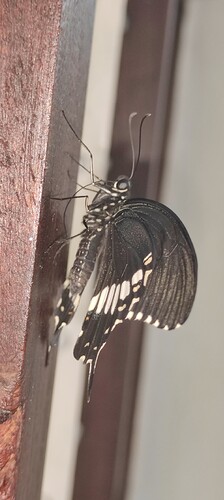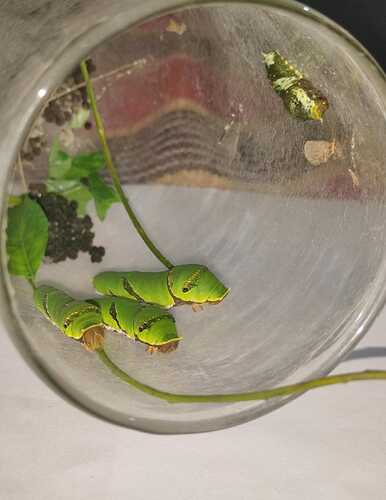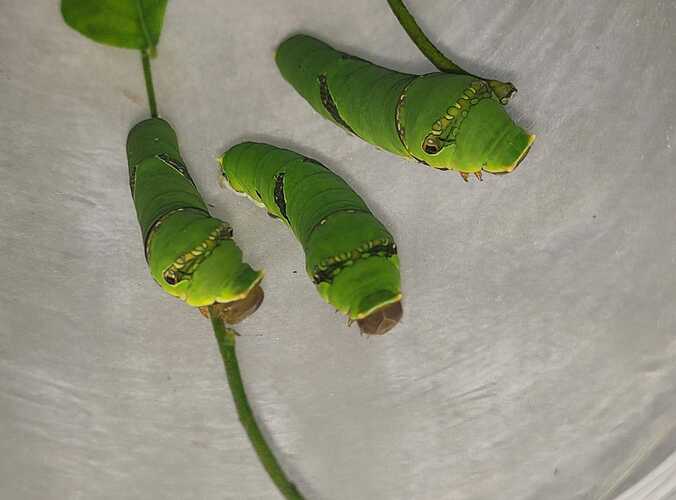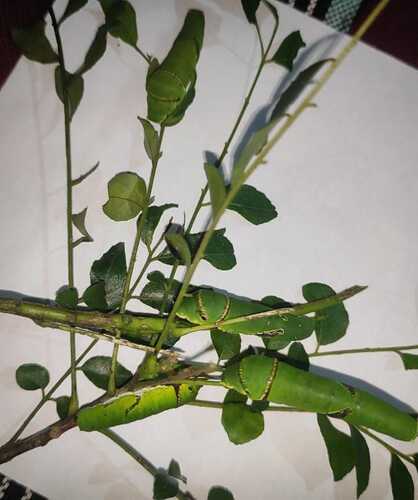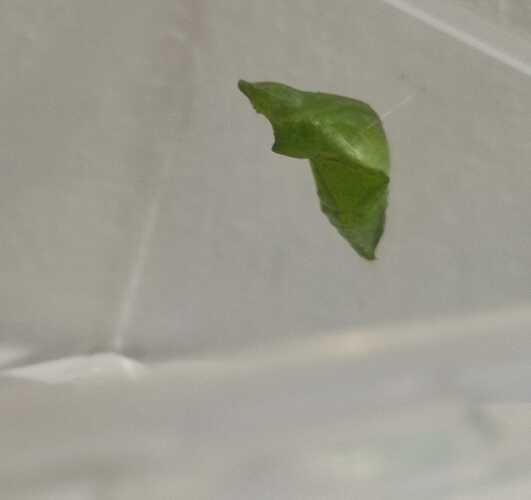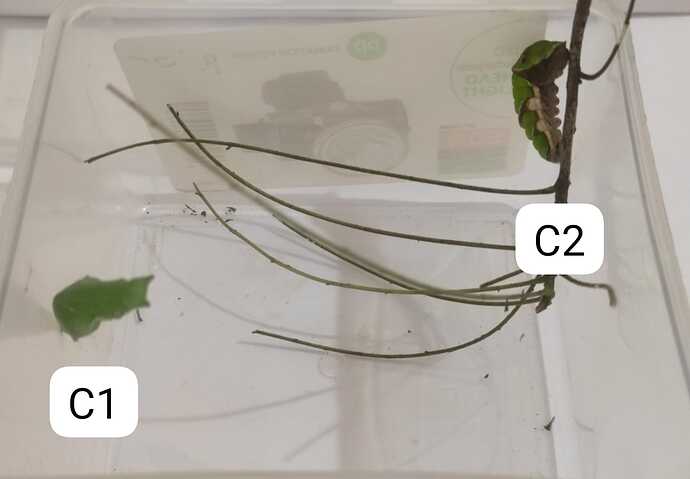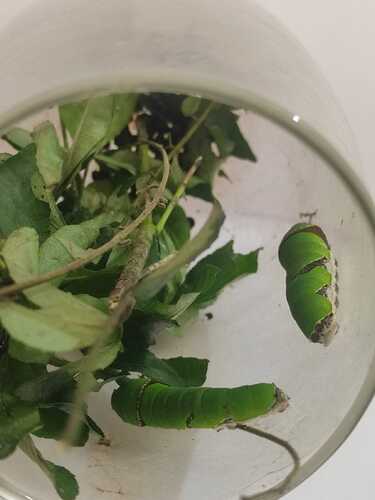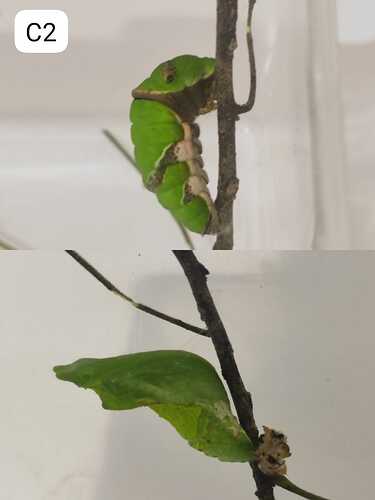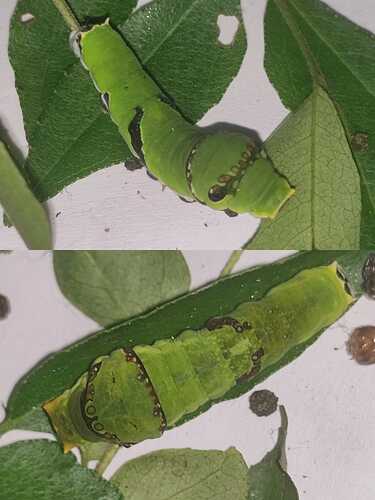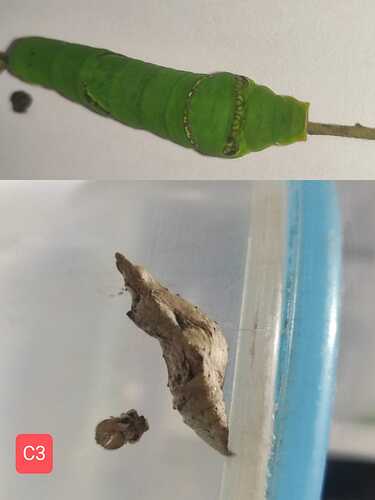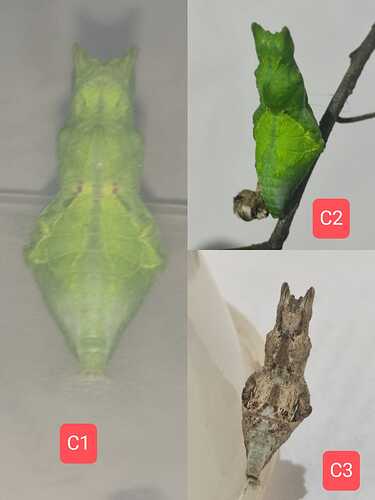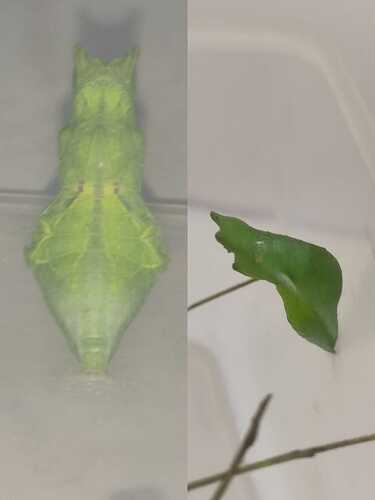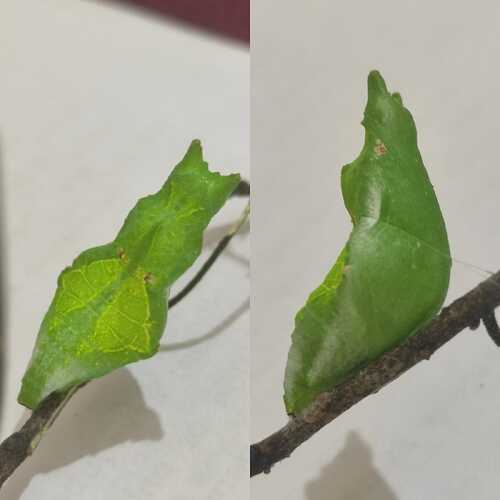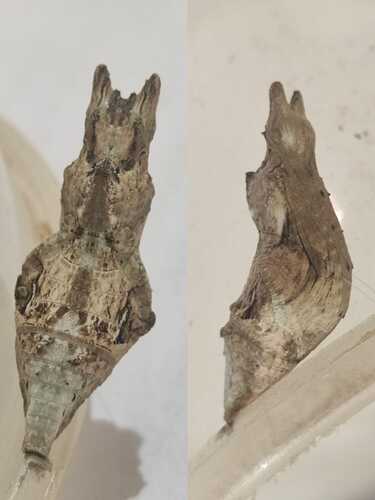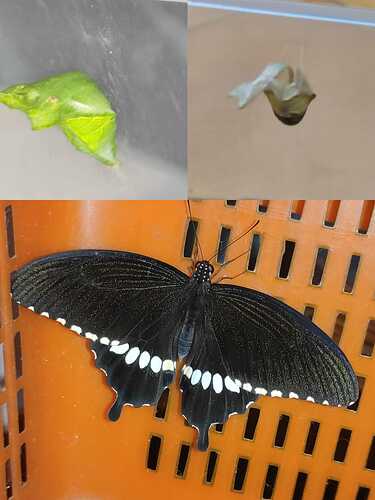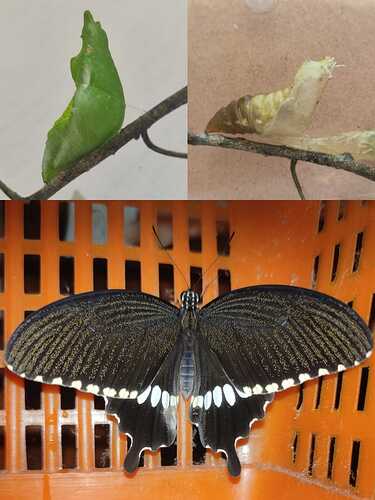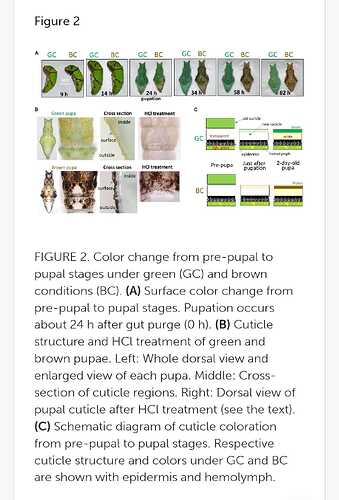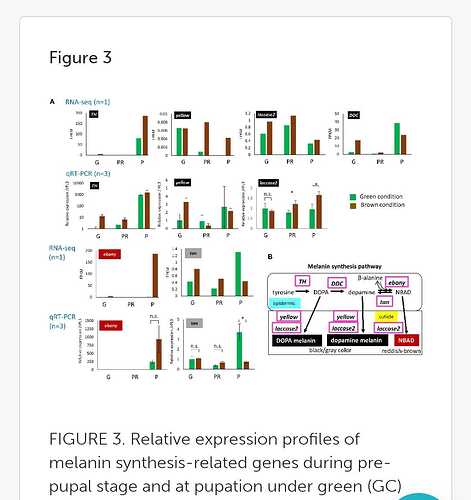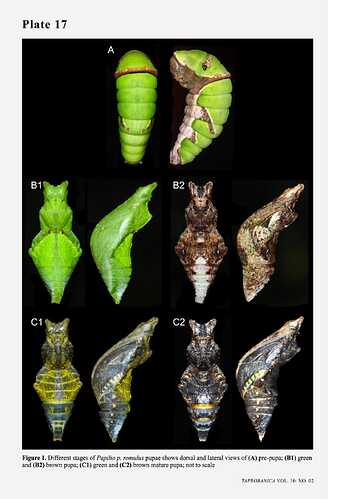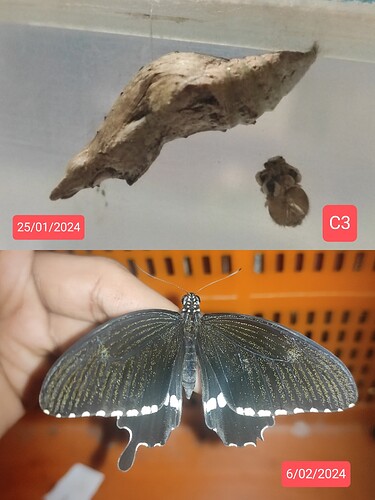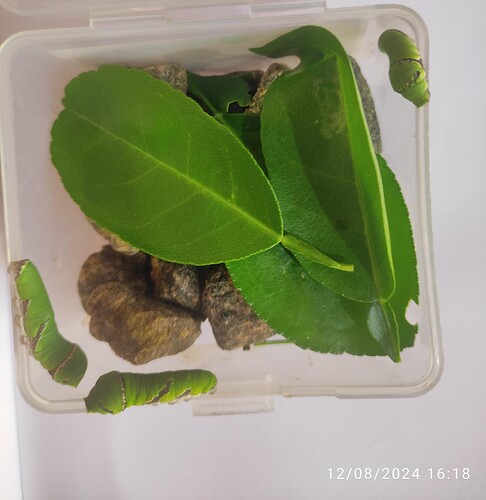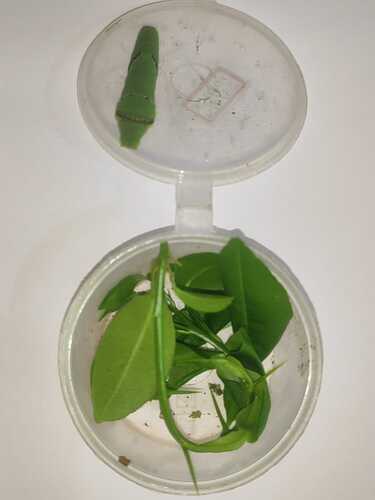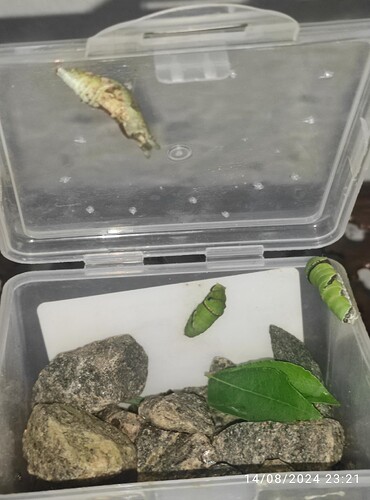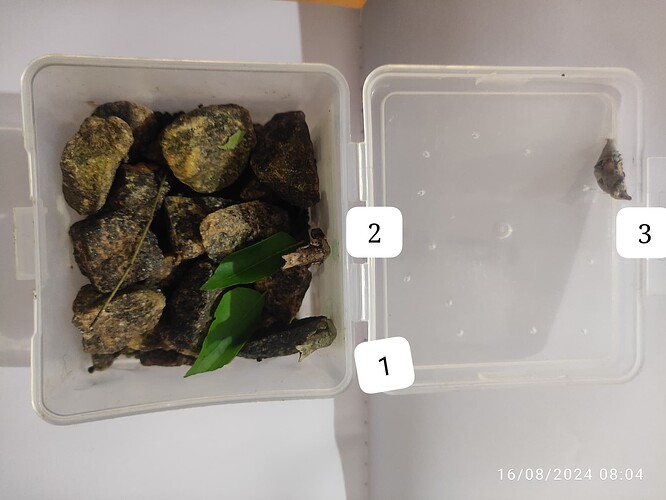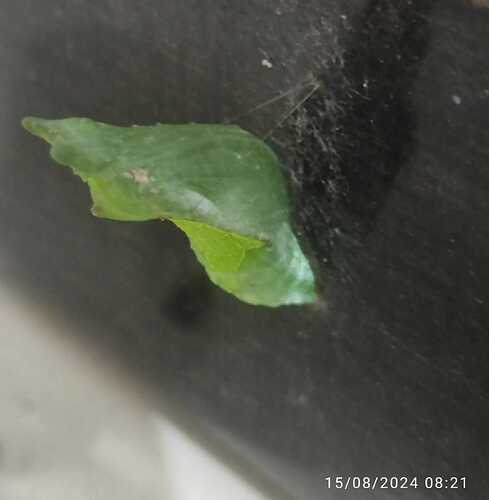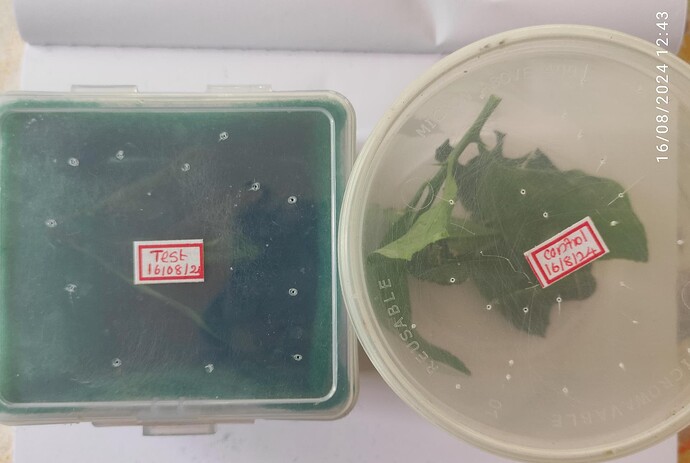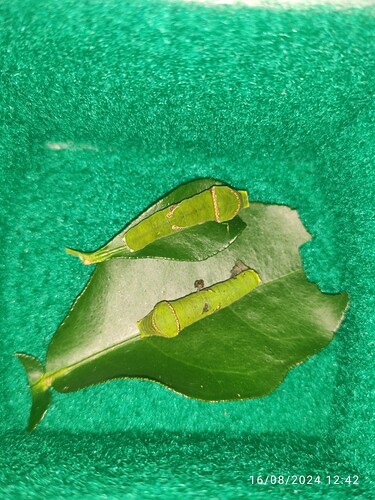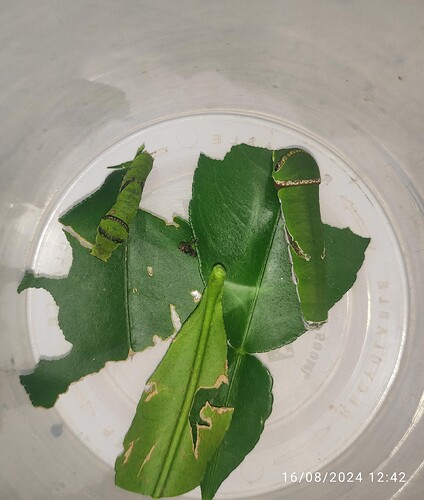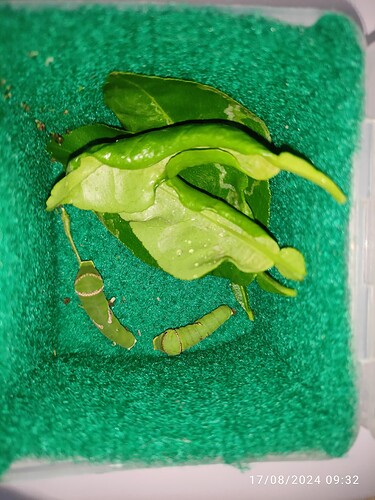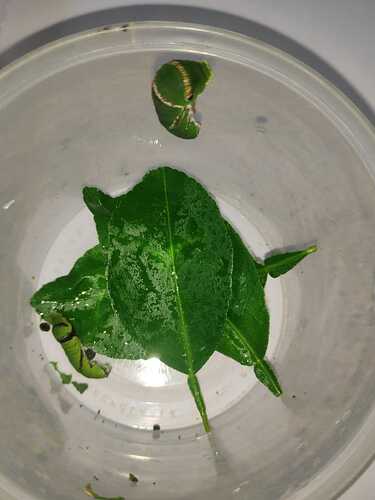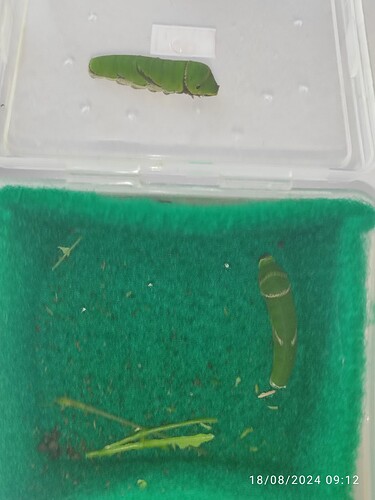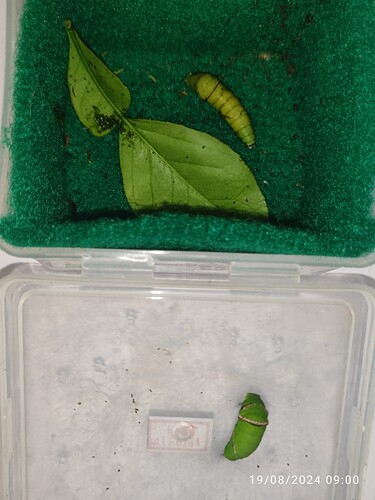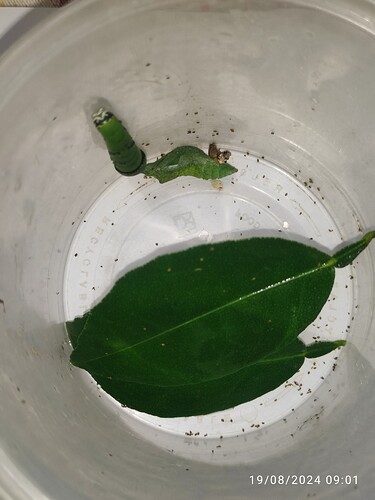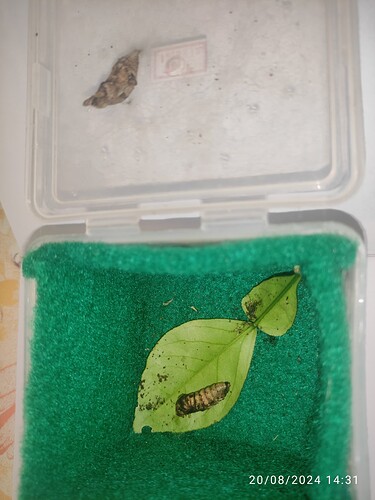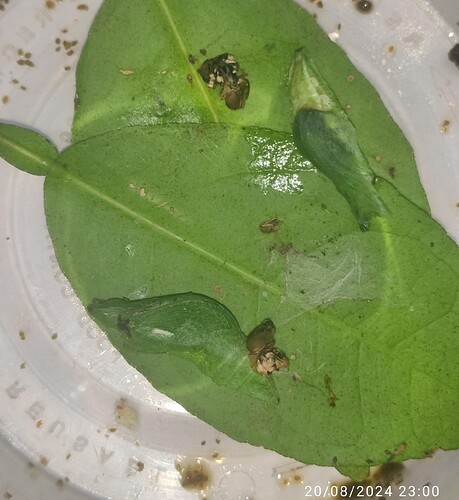Change in pupal coloration:Common mormon
How do different environment influence Common mormon to have two different pupal color !?
Is that environment matter ?
What all factors are responsible for pupal coloration?
Recently i observed in my Homelab that two different colored pupa of common mormon .
Host plants of Common mormon:
Papilio polytes romulus - Aegle marmelos (Wynter-Blyth 1957; Kunte 2000; Robinson et al. 2010), Atalantia racemosa (Kunte 2006), Citrus (Robinson et al. 2010), Citrus aurantiifolia (Wynter-Blyth 1957; Kunte 2000; Robinson et al. 2010), Citrus maxima (Wynter-Blyth 1957; Kunte 2000), Citrus limon (Wynter-Blyth 1957; Kunte 2000), Citrus medica (Wynter-Blyth 1957; Kunte 2000; Robinson et al. 2010), Clausena anisata (Saji et al. 2018), Correa (Robinson et al. 2010), Glycosmis (Robinson et al. 2010), Glycosmis pentaphylla (Wynter-Blyth 1957; Kunte 2000), Murraya (Robinson et al. 2010), Murraya koenigii (Wynter-Blyth 1957; Kunte 2000; Robinson et al. 2010), Murraya paniculata (Wynter-Blyth 1957; Kunte 2000), Ravenia spectabilis (P. Churi pers. obs. 2017), Triphasia (Wynter-Blyth 1957; Kunte 2000; Robinson et al. 2010), Zanthoxylum (Robinson et al. 2010), Zanthoxylum rhetsa (Wynter-Blyth 1957; Kunte 2000) (Rutaceae).
Papilio polytes Linnaeus, 1758 - Common Mormon | Butterfly.
I observed Common mormon caterpillars or eggs in Murraya and citrus plant .
Lifecycle of Common mormon.
Egg > caterpillar>pupa >butterfly.
Reference
My observations:
I am little doubtful about the characteristics of third instar larvae.
To me it’s looks similar to first instar larvae but length is different.please correct me if iam wrong:
Egg:
First instar:
Second instar:
Third instar:
Fourth instar:
Fifth instar:
Pupae:
Butterfly:Common mormon
Updates
Happily growing Caterpillars
Collected caterpillars from Curry leaf plant on 12/01/2024.
Place : Cherukkad, Kozhikode
Date:17/1/2024
Theertha
Updates of caterpillars:
Caterpillars are Collected from Curry leaf plant on 12/01/2024.
Expected to be of Common mormon.
Three of the caterpillars are in 5th Instar larval stage and one in fourth instar stage.
Place: Cherukkad, Kozhikode
Date:19/01/2024
Time:11.30pm
Theertha
Three of them in 5th Instar larval stage.
Place: Cherukkad, Kozhikode
Date:19/01/2024
Time:11.30pm
Theertha
One in one in fourth instar stage.
Place: Cherukkad, Kozhikode
Date:19/01/2024
Time:11.30pm
Theertha
Four of them are in 5th instar larval stage .
Place: Cherukkad, Kozhikode
Date:20/01/2024
Time:11pm
Theertha
I observed some greenish excretion from two of the caterpillars .
I had noticed similar occurrences earlier, and shortly after that they transformed into pupae.
What actually it is ?
I transferred two caterpillars exhibiting greenish excretion to a new box, And expecting pupa with in 24 hr.
Place: Cherukkad, Kozhikode
Date:21/01/2024
Time:3.50pm
Theertha
C1
Caterpillar 1 in pupal stage .
Place: Cherukkad, Kozhikode
Date:21/01/2024.
Time:11pm
Theertha .
C1 in pupal and C2 in fifth instar larva to pupa transition stage.
Expect C2 in pupal stage with in 24hr.
Place: Cherukkad, Kozhikode
Date:22/01/2024.
Time:12pm
Theertha .
C3& C4 still in fifth instar larval stage.
Place: Cherukkad, Kozhikode
Date:22/01/2024.
Time:12pm
Theertha .
C2 in pupal stage now.
Place: Cherukkad, Kozhikode
Date:22/01/2024.
Time:11.50pm
Theertha .
*Features of fifth instar of larval stage:Common mormon found following features from the references:
1)Pastel (soft, delicate shades of colour)purplish bluish slits.
2)Two transverse sinus (what is the function of sinus in caterpillar?)@shalini CUBE @Lakshmy CUBE & others markings band; first
one is connected two eye spots and another
is connected 3 thoracic and 1 abdominal segment.
3)Kohl( a substance that darken the area around the eyes)like stripe present behind the last thoracic segment.
4)Black oblique bar running from the base of 3 abdominal segment to the top of the 4th segment.
5)Black oblique bar on last abdominal segment.
Photo : Theertha
Place: Cherukkad, Kozhikode
I lost one of the caterpillar ,I forgot to cover the pot and the next day morning one caterpillar was missing . expectation: may be that caterpillar changed to a pupa in somewhere in my room.
And finally the 3rd caterpillar changed to a pupa on 25/01/2024 .
Place : Cherukkad, Kozhikode
Date:25/01/2024
Theertha
What may be the reason of the change in the pupal color ? C1 and C2 caterpillar had green colored pupa but C3 is looks like a hard stick !?
Place : Cherukkad, Kozhikode
Date:27/01/2024
Theertha
C1
Pupa of Common mormon.
Place : Cherukkad, Kozhikode
Time :9.30am
Date:27/01/2024
Theertha
C2.
Pupa of Common mormon.
Place : Cherukkad, Kozhikode
Time :9.30am
Date:27/01/2024
Theertha
C3.
Pupa of Common mormon.
Place : Cherukkad, Kozhikode
Time :9.30am
Date:27/01/2024
Theertha
C1 emerged at 4pm on 1/02/2024.
Place : Cherukkad, Kozhikode
C1 :Male, Common mormon
Pupal color:Green
Date:1/02/2024
Time :4pm
Theertha.
https://news.ncbs.res.in/archivednews/story/doublesex-doubles-gender-differentiator-and-mimicry-supergene#:~:text=The%20male%20Common%20Mormon%20has,Pachliopta%20aristolochiae%20and%20the%20Crimson
C2 : Female,Common mormon
Pupal color:Green
Place : Cherukkad, Kozhikode
Date:2/02/2024
Time :8am
Theertha.
https://news.ncbs.res.in/archivednews/story/doublesex-doubles-gender-differentiator-and-mimicry-supergene#:~:text=The%20male%20Common%20Mormon%20has,Pachliopta%20aristolochiae%20and%20the%20Crimson
Article related to Pupal color change:
*Molecular Mechanisms Underlying Pupal Protective Color Switch in Papilio polytes (Common mormon). Butterflies : These analyses revealed that the brown pupal color is regulated mainly by melanin synthesis genes, tyrosine hydroxylase (TH) and laccase 2. In contrast, the green pupal color was suggested to be formed mainly through the expression of both multiple bilin binding protein (BBP)-related genes responsible for blue pigmentation and multiple juvenile hormone binding protein (JHBP)-related genes responsible for yellow pigmentation.
Green or brown appearance of pupae depends mainly on the pigments localized in the cuticle surface. To further characterize the pigments, we treated the cuticles with 6N HCl at 90°C for 120.
We found that the green color in green pupae was lost upon this treatment, while the brown color of brown pupae was retained, suggesting that the brown color but not the green color is mainly composed of melanin-related pigment (Shirataki et al., 2010). The above observation indicates that green and brown pupal coloration (pigment formation) occurs at the exterior of the cuticle (epicuticle) mainly after P (Figure 2C).
Genes Differentially Expressed Between Green and Brown Conditions
It has been suggested that the P. xuthus pre-pupae sense environmental factors (mainly in the form of tactile stimulation) before and after G (about 7 h after GP) and that the pupal colors are pre-determined during the pre-pupal stage (Hiraga, 2006). It is assumed that an unidentified neuropeptide that induces the brown coloration is excreted from the brain at least before P because the brown (and green) pigment formation mainly occurred after P, as shown above. Thus, we speculate that gene regulation during the pre-pupal stage to P is essential for dimorphic pupal coloration.
Updates on Common mormon Pupae:
Objective: To find out the possible reason behind varying pupal coloration in Common mormon.How!?
Place : Cherukkad, Kozhikode
Time :11pm
Date:28/01/2023
Theertha .
Breaking news: Similar observation reported in Common mormon by Eranda et.al.
Paper published on November 2021.
Relationship Between Pupal Colour and Sex Ratio of the Common Mormon, Papilio polytes romulus:
A free ranging female common Mormon (Papilio polytes romulus) butterfly was observed laying eggs on a Citrus aurantiifolia (Family: Rutaceae) plant in a home garden in Battaramulla. 16 eggs were collected and reared in the lab. The duration and measurements of each stage were recorded. After eclosion the sex and wingspan of all adult butterflies were recorded and they were released back to the wild. Pupae were observed in two colours: green and brown. Out of 16 pupae, 12 were green (75%) and four were brown (25%). The four brown pupae gave rise to two males (50%) and two females (50%). The 12 green pupae gave rise to 10 males (83%) and two females (17%). The sex ratios regardless of the pupal colour showed male dominance with 12 males (75%) and four females (25%).
A strong relationship between pupal colour and substrate texture was observed, but no relationship between pupal colour, sex and sex ratios was seen.
This is consistent with the fact that smooth substrate texture (glass wall) favours green pupa formation while rough substrate texture (sticks) favours brown pupa formation. Other environmental factors such as season, type of larval food plant, captive vs non-captive setting and distribution zones also need to be investigated in order to fully understand this relationship.
